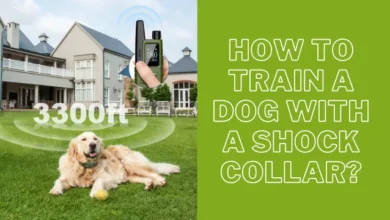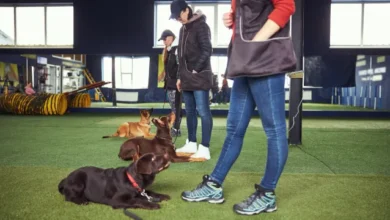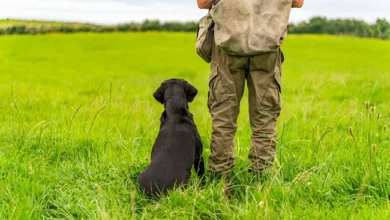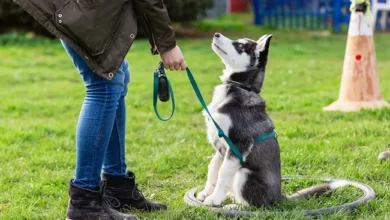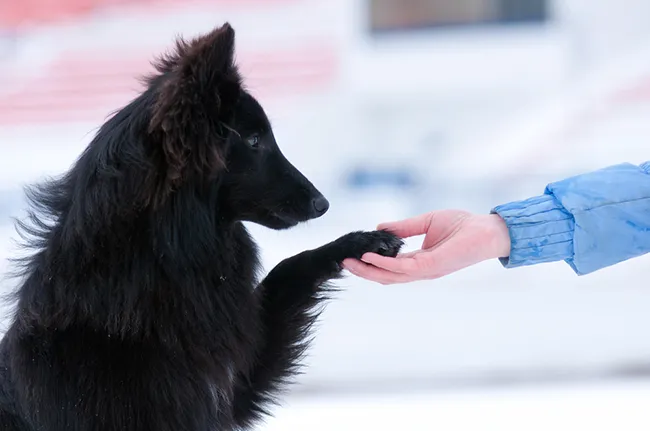
Hey there, fellow dog lovers! Ever watched a dog perform an awesome trick and thought, “Wow, I wish my pup could do that”? Well, you’re in the right place! From the classic shake and roll over to the show-stopping spin and adorable beg, teaching your furry friend some cool tricks is not just a party hit; it’s a fantastic way to keep their minds sharp and bodies active. Plus, it’s an incredible opportunity to strengthen that special bond you share. And guess what? You don’t need to be a dog whispering guru to get started. Whether you’re a seasoned pro or a newbie pup parent, I’ve got a lineup of 32 super cool tricks that will turn your dog into the neighborhood superstar in no time. So, let’s dive in and start having some fun with our four-legged pals!
Quick Tips
Hey, don’t stress if your dog isn’t picking up tricks as fast as you hoped. Each pup is unique! Keep your training sessions fun and short, mix it up to keep things fresh, and don’t forget to shower them with treats and love. Celebrate every little win together, and remember, it’s all about having a good time and bonding. You’ve got this!
Why Is Practicing Tricks Useful?
Let’s dive into why teaching your dog new tricks is not just fun but fundamentally enriching for both of you:
The Magic of Basic Training
Imagine basic training as the first chapter of an epic novel you and your dog are writing together. It’s where everything begins. These initial lessons, like ‘sit’, ‘stay’, and ‘come’, aren’t just about commands; they’re the building blocks of a language that you and your dog will use to communicate effectively. This foundational training ensures your day-to-day life flows smoothly, whether it’s avoiding a little chaos at home or navigating the outside world. It lays down the groundwork for a well-mannered pup who knows what’s expected of them, making your bond stronger and your adventures together stress-free.
Strengthening Your Bond Through Training
Training sessions are more than just learning tricks; they’re golden opportunities to deepen the bond you share with your dog. These moments are when trust is built and mutual understanding grows. You become more than just an owner and a pet; you transform into a true team, a partnership built on respect and love. This connection provides your dog with a sense of security and belonging, knowing they have a place in your world where they are cherished and understood.
Mental Stimulation: A Must for a Happy Pup
Physical exercise is great, but don’t forget about giving your dog’s brain a workout too! Teaching tricks is akin to putting your dog through a mental agility course, challenging their brain and keeping them sharp. This mental exercise is crucial for their overall well-being, keeping them engaged, curious, and mentally fit. A mentally stimulated dog is a content dog, less prone to anxiety and unwanted behaviors borne out of boredom. Watching your dog’s excitement as they grasp a new trick is a testament to the joy and satisfaction these mental challenges bring them.
Engaging in trick training transcends the mere act of teaching new skills; it’s about building a foundation of communication, nurturing a deep, trusting relationship, and ensuring a balanced regimen of mental and physical health for your furry friend. It’s one of the most rewarding journeys you can embark on with your dog, filled with moments of pride, joy, and lots of laughter. So, why wait? Start this incredible journey today, and witness the wonderful transformation that awaits both of you.
Table of Contents
- Why Is Practicing Tricks Useful?
- 25 Cool Tricks to Teach Your Dog
- Frequently Asked Questions
25 Cool Tricks to Teach Your Dog
Basic Cool Tricks To Teach Your Dog
Oh, diving into basic commands is like unlocking the first level of an exciting game with your furry buddy! Let’s break it down in a fun, friendly way:
1. Sit
“Sit” is pretty much the bread and butter of dog tricks, and for good reason. It’s super simple but oh-so-crucial for your pup to master. Think of it as the ultimate go-to command for a ton of everyday scenarios—like pausing patiently at those pesky traffic lights.
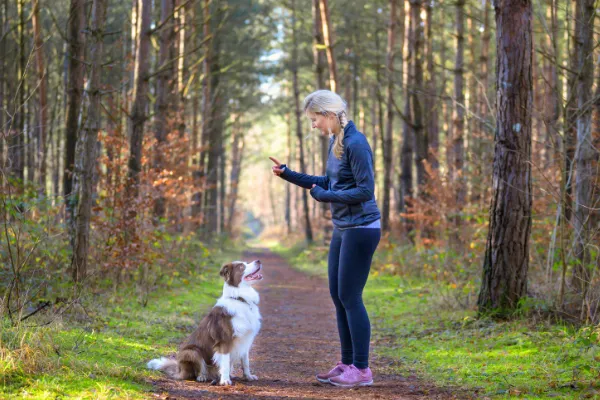
Here’s a little step-by-step to get your dog acing the “sit” command: Start by holding a tasty treat just above your dog’s nose. Then, slowly lift your hand up. Your dog’s eyes (and nose!) will follow the treat, and their bottom will naturally hit the ground. Boom—that’s the sitting position. Once they nail it, make sure to reward them with the treat.
As you both get more comfortable with this trick, begin to introduce a hand signal along with a verbal “sit” command. Practice in various settings to help your pup get the hang of sitting amidst different distractions. It’s all about building up from those basics to create a well-rounded, obedient companion who can “sit” like a champ anywhere, anytime.
And just like that, you’re on your way to having a dog who’s not just a good boy or girl but a sitting superstar. Keep at it, and soon enough, “sit” will be second nature for your furry friend!
2. Down
Teaching your dog to “down” on command is like unlocking a new level in your training game. Not only is it impressive to showcase, but it also lays the groundwork for a bunch of other tricks, such as the crowd-pleaser “roll over.” Plus, it’s incredibly handy for those moments when you need your dog to settle down, whether you’re at home or out and about.
Getting your dog to master the “down” command is surprisingly straightforward. Start with your dog in a sitting position, which you’re both likely pros at by now. Next, take a treat and lower it to the ground, right in front of their nose. You might even want to draw the treat towards you slightly. Your dog’s instincts to follow the treat will do the rest, guiding them into the lying down position.
Once their belly and chest are cozily against the ground, that’s your cue to introduce your chosen word signal (like “down”) and reward them with the treat. With a bit of practice, you can transition to using just a flat hand gesture instead of the treat to signal the “down” command.
For those who love a visual guide or need a bit more help, there are plenty of resources and instructional videos out there to make learning fun and effective for both you and your pup. Keep practicing, and soon “down” will be another trick in your dog’s repertoire, ready to impress and serve you in daily life!
3. Stay – The Art of Patience
The “Stay” command is a cornerstone of basic dog obedience, teaching your furry friend to remain in one spot until you say otherwise. This command is a lifesaver in many situations, like preventing a cheerful greeting from turning into an escape act whenever someone rings the doorbell.
To start teaching “Stay,” you’ll want your dog in a sitting position. Then, with the authority of a gentle traffic cop, extend your hand out in front like a visual “stop” signal and firmly say, “Stay.”
Patience is key here—for both of you. Begin with short periods of staying put, then gradually extend the time and distance between you and your dog, sprinkling in some distractions as you go. The secret sauce? Your dog earns their treat by mastering the art of staying still, not by breaking the stay too soon.
If your dog decides to get up before you’ve given the cue, no worries—just guide them back and try again. It’s all about consistency and building up their ability to stay put, even when they’d rather be sprinting towards the door or chasing a squirrel. Stick with it, and soon “Stay” will become a reliable and useful tool in your dog training toolkit.
4. Give Paw
Teaching your dog to “give paw” is not just a cute trick; it’s a fun way to bond and a great starter trick that can lead to learning more complex commands. Plus, who can resist those adorable puppy eyes when they’re politely offering you their paw? Here’s the easiest way to get your furry friend to master this classic move:
- Get Their Attention: Grab your dog’s favorite treat to capture their interest. Make sure you have their full attention before you start.
- Sit Position: Have your dog sit down. This starting position makes it easier for them to balance and lift one paw.
- Introduce the Command: Hold the treat in one hand and say “give paw” while gently lifting one of your dog’s paws with your other hand. Some prefer to wait and see if the dog lifts a paw naturally when they reach for the treat, but both methods work well.
- Praise and Treat: As soon as their paw touches your hand, give them the treat and lots of praise. The positive reinforcement will make them eager to repeat the action.
- Repeat: Practice this trick a few times in short, enjoyable sessions. Dogs respond best to short bursts of training that end on a high note.
- Gradual Fade of Assistance: Once your dog starts lifting their paw consistently with the command, start to reduce the physical assistance you provide. Eventually, your dog will give their paw with just the verbal cue and the sight of your open hand.
- Patience and Consistency: Like any trick, “give paw” requires patience and consistency. Celebrate each small success and keep the training sessions fun and stress-free.
Remember, every dog learns at their own pace, so if yours doesn’t get it right away, don’t worry. Just keep practicing, stay positive, and soon your dog will be giving paw like a pro. It’s one of those heartwarming tricks that never gets old, whether you’re showing off to friends or just enjoying a quiet moment with your best pal.
5. High Five
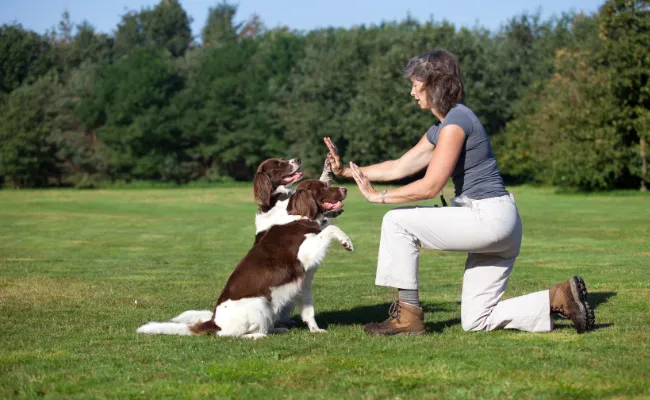
Teaching your dog to “high five” is a cool twist on the classic “give paw” trick, and it’s just as fun to learn! Once your dog has mastered giving their paw, transitioning to a high five is a breeze, and it’s a fantastic way to impress friends and family. Here’s how to get those paws up for a celebratory slap:
- Start with “Give Paw”: Make sure your dog is comfortable with the “give paw” trick. This forms the base for learning “high five.”
- Get Your Dog’s Attention: Have some treats ready to capture your dog’s interest. A hungry pup is an eager learner!
- Raise the Stakes: Instead of holding your hand low for a paw shake, raise it slightly higher and in front of your dog. Use the command “high five” as you do this. The new position encourages your dog to lift their paw higher.
- Touch and Treat: When your dog lifts their paw to meet your hand, make sure to touch their paw with your palm, much like a real high five, and then immediately reward them with a treat and lots of praise.
- Practice Makes Perfect: Repeat the process several times in short, fun training sessions. Consistency is key, so try to practice the “high five” trick regularly.
- Gradual Elevation: As your dog gets the hang of it, gradually raise your hand higher to encourage a more pronounced high five motion. Just be sure not to go too high – you want to keep it comfortable for your pup.
- Encouragement and Patience: Every dog learns at their own pace, so offer plenty of encouragement and be patient. Celebrate every success, no matter how small, to keep the training positive and enjoyable for both of you.
Before you know it, your dog will be slapping high fives like a pro, ready to show off their new skill at any opportunity. It’s a fun and interactive trick that not only strengthens your bond but also adds an extra element of play to your daily routine. So grab some treats, and let the high-fiving begin!
Useful Cool Tricks To Teach Your Dog
6. Stop
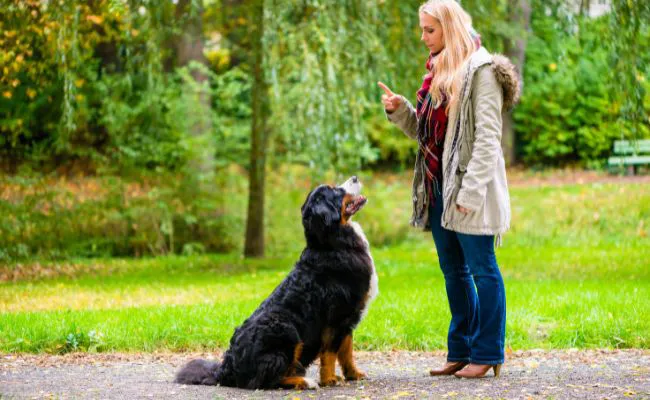
let’s simplify teaching your dog the “Stop” command. It’s all about keeping them safe and giving you peace of mind during your adventures together. Here’s a straightforward approach:
- Quiet Spot: Start in a calm place where your dog can focus on you without distractions.
- Pick Your Word: Decide on a clear command word like “Stop.” Use the same word every time so your dog doesn’t get confused.
- Show and Tell: When you’re both relaxed, say “Stop” and gently make your dog stop moving using the leash or by blocking their path. A hand signal, like holding your palm up, can also help them understand.
- Treat Time: Right after they stop, even if you helped them, give them a treat and some love. This makes stopping a good thing in their eyes.
- Repeat in Fun Places: Once they get good at stopping in your quiet spot, try it out in slightly busier places to help them learn to stop even with distractions around.
- Practice Makes Perfect: Keep practicing by increasing the distance between you and adding more distractions gradually. This will help your dog understand they need to stop no matter where they are or what’s happening around them.
- Keep It Positive: Always use a happy voice and give treats for stopping. If they don’t get it right away, that’s okay! Just try again.
Teaching “Stop” is super important for your dog’s safety and doesn’t have to be complicated. With some treats, patience, and practice, your dog will be a pro at stopping on command, ready to safely enjoy all your adventures together.
7. Nudge Your Nose
Teaching your dog to “nudge your nose” is a sweet and simple trick that not only adds an adorable move to their repertoire but also deepens the bond between you two. Here’s how to teach it easily:
- Get Their Favorite Treat: Start with something irresistible to your dog. This will be the key to keeping their attention and making learning fun.
- Show the Treat: Hold the treat in your hand close to your face, ideally near your nose, to draw their interest right where you want it.
- Encourage the Nudge: With the treat near your nose, wait for your dog to try and get it. Most likely, they’ll use their nose to nudge your hand as they attempt to access the treat. When they do, let them gently touch your nose with theirs.
- Give the Command: Right before or as they nudge your nose, say your chosen command—something like “nudge” or “boop.” This will help them associate the action with the word.
- Reward Immediately: As soon as their nose makes contact with yours, reward them with the treat and lots of praise. The immediate positive reinforcement helps them understand that nudging your nose is a good thing.
- Repeat: Practice this trick in short, enjoyable sessions. Repetition is key, but keep it fun and stress-free.
- Lessen the Treat Guidance: Gradually, start using the command without guiding them with a treat every time. Your dog will learn to nudge your nose on command, expecting praise and perhaps an occasional treat as a reward.
- Practice and Patience: Remember, every dog learns at their own pace. Practice consistently, but be patient and keep each training session light and enjoyable.
This trick is not just about teaching your dog something new; it’s a gentle way to strengthen your connection and enjoy close, affectionate moments together. Plus, it’s a guaranteed crowd-pleaser that showcases the sweet bond you share with your furry friend.
8. Lie Head Down
Teaching your dog to “lie head down” is a serene and endearing trick that can also help calm them. This trick is great for photo ops and just enjoying a quiet moment together. Here’s how to teach it in a simple and enjoyable way:
- Start With ‘Down’: Make sure your dog is comfortably lying down. This starting position makes it easier for them to rest their head down.
- Use a Treat: Grab a treat that your dog loves. Hold it in your hand and make sure you have their attention.
- Guide the Treat: Slowly move the treat from your dog’s nose towards the floor, between their front paws. The natural movement for them to follow the treat with their nose should encourage them to lay their head down.
- Reward the Position: As soon as your dog’s head touches the ground, use a specific command like “head down” or “rest” and give them the treat. Shower them with praise to reinforce that they’ve done something great.
- Repeat and Practice: Consistency is key. Repeat the trick a few times during each training session, but keep these sessions short and sweet to avoid any frustration.
- Fade the Treat: Once your dog starts to understand the command, begin to reduce the use of the treat to guide them. Use just the command and a hand gesture, rewarding them after they perform the trick based on the command alone.
- Patience and Encouragement: Every dog learns at their own pace. Some might pick this up quickly, while others may need a bit more practice. Encourage them with gentle guidance and plenty of praise for their efforts.
This trick not only adds a cute move to your dog’s skill set but also promotes relaxation and trust. It’s a wonderful addition to your dog’s trick repertoire and a beautiful way to deepen your bond. Plus, it’s a perfect trick for those moments when you need them to settle down quietly by your side.
9. Eye Contact
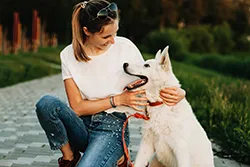
Teaching your dog to maintain eye contact is a fundamental trick that enhances communication and strengthens your bond. It’s more than just a trick; it’s a foundational skill that improves focus and attention. Here’s a simple and effective way to teach your dog the “Eye Contact” trick:
- Find a Quiet Spot: Choose a place with few distractions to start your training sessions, making it easier for your dog to focus on you.
- Get Their Favorite Treats: Have some of your dog’s favorite treats in hand to capture their attention and motivate them.
- Hold a Treat Close to Your Eyes: Start by holding a treat up to your eyes. This encourages your dog to look directly at your face. The goal is to associate your eyes with something positive.
- Use a Command Word: Choose a command word like “look” or “eyes.” Say it the moment your dog makes eye contact, even if it’s just for a second.
- Reward Immediately: As soon as your dog makes eye contact, reward them with the treat and enthusiastic praise. This positive reinforcement helps them understand that making eye contact is a good thing.
- Increase Duration Gradually: Initially, reward any eye contact, no matter how brief. Over time, start delaying the treat for longer periods of eye contact. Gradually increase the duration they need to hold your gaze before they get the reward.
- Practice Regularly: Consistent, short training sessions are more effective than less frequent, longer ones. Practice for a few minutes daily to reinforce the behavior.
- Add Distractions: Once your dog has mastered eye contact in a quiet environment, practice in different locations with more distractions. This helps your dog learn to focus on you even in stimulating or challenging situations.
- Patience is Key: Remember, every dog learns at their own pace. Be patient and keep the sessions enjoyable. If you or your dog gets frustrated, take a break and try again later.
Eye contact is a powerful tool in dog training, promoting better communication and enhancing your relationship. It’s the basis for advanced training and ensures your dog pays attention when learning other commands and tricks. Plus, it’s a wonderful way to share moments of connection with your furry friend.
10. Place
Teaching your dog the “Place” trick is a fantastic way to help them find a calm and relaxing spot in your home. It’s not just a trick; it’s a cue for them to chill out and settle down, making it incredibly useful. Here’s how to teach it simply and effectively:
- Pick the Spot: Start by choosing a specific place, like a mat or bed, that you want your dog to go to. This will be their “Place.”
- Introduce the Place: Lead your dog to the spot and encourage them to explore it. You can use treats to make this new place interesting and inviting.
- Name the Spot: As your dog steps onto the mat or bed, use a command like “Place” or “Bed.” It helps them associate the action with the command.
- Reward: Once your dog is on their spot, give them a treat and praise them. Make sure they understand that being in their place is a good thing.
- Practice with Commands: Start stepping away and using the command “Place” to encourage your dog to go to their spot from different distances. Reward them every time they succeed.
- Increase Duration: Begin asking your dog to stay in their place for longer periods before rewarding them. You can use the “stay” command if they already know it, gradually extending the time before giving a treat.
- Add Distractions: Once your dog is doing well, introduce mild distractions to practice. The goal is for them to stay in their place despite what’s happening around them.
- Keep it Positive: Always use positive reinforcement like treats and praise. If your dog gets up or leaves their place, gently guide them back without scolding.
- Consistency is Key: Practice this trick daily, keeping sessions short and sweet. Consistency helps your dog understand what’s expected of them.
Teaching your dog to go to their “Place” is not just about performing a trick; it’s about giving them a safe haven where they can relax and feel secure. It’s a valuable skill for managing excitement and anxiety, and with patience and consistent practice, your dog will learn to love their special spot.
11. Play Dead
Teaching your dog to “Play Dead” is a fun trick that looks more complicated than it actually is. Here’s a simpler way to go about it:
- Start with “Down”: Get your dog into a lying down position, which is the starting point for this trick.
- Pick a Cue: Decide on a word like “Bang!” or a simple hand gesture to signal the start of the trick.
- Lure with a Treat: With your dog lying down, use a treat to guide them to roll onto their side. Move the treat from their nose toward their shoulder to encourage them to lie on their side.
- Introduce Your Cue: As they start rolling to their side, say your cue word or show your hand signal. Then, immediately give them the treat.
- Repeat and Reward: Keep practicing, rewarding your dog every time they successfully “Play Dead” after hearing the cue.
- Less Treat, More Cue: Gradually reduce using the treat to guide them and rely more on your cue. Always reward them after they perform.
- Short and Sweet: Keep your training sessions brief but frequent to maintain their interest and fun.
With patience and consistent practice, your dog will soon be “playing dead” like a pro, ready to impress everyone with their adorable new trick!
12. Speak
Teaching your dog to “Speak” on command is a practical trick that not only impresses onlookers but also gives you control over their barking. Here’s how to teach it simply:
- Find the Trigger: Notice what naturally makes your dog bark, like the doorbell or seeing a ball. You’ll use this to encourage barking.
- Cue and Reward: When your dog barks in response to the trigger, immediately say “Speak,” and then give them a treat. This helps them connect the command with the action of barking.
- Repeat: Continue to use the trigger, command, and reward process several times. Consistency is key to helping your dog learn.
- Command Without Trigger: Once your dog starts to understand, try using the “Speak” command without the trigger and reward them when they bark. If they don’t bark, go back a step and use the trigger again.
- Introduce “Quiet”: To fully control barking, teach “Quiet” in the same way. After your dog barks and you’ve said “Speak,” wait for a moment of silence, say “Quiet,” and then reward them.
Remember, patience and positive reinforcement are crucial. Keep sessions short and fun, and your dog will be speaking on command in no time, giving you a way to manage their barking more effectively.
13. Fetch
Teaching your dog to “Fetch” is a classic trick that combines fun and exercise, and it’s easier to teach than you might think. Here’s a straightforward approach:
- Choose the Right Toy: Pick a toy that your dog loves and is willing to chase. This will make them more motivated to participate.
- Get Their Interest: Start by showing your dog the toy and getting them excited about it. You can do this by waving it around or playing a little tug-of-war.
- Throw the Toy: Once your dog is focused on the toy, throw it a short distance. Use an excited tone to encourage them to chase after it. The first few times, you might want to throw it only a few feet away.
- Introduce the Command: As you throw the toy, say “Fetch” so that your dog starts to associate the action with the word.
- Celebrate the Retrieve: If your dog picks up the toy, encourage them to come back to you with it. You can do this by calling their name, showing them another toy, or even running a few steps in the opposite direction to prompt them to follow you.
- Trade for a Treat: Once your dog returns with the toy, offer a treat in exchange for dropping the toy. This helps them learn that bringing the toy back results in a reward. Over time, you can replace the treat with enthusiastic praise.
- Repeat and Reward: Keep practicing, gradually increasing the distance you throw the toy. Always reward your dog with praise or a treat for retrieving the toy and bringing it back to you.
- Patience and Consistency: Some dogs may naturally grasp the idea of fetching more quickly than others. Be patient and consistent with your training, and make sure each session is fun and stress-free.
With regular practice and positive reinforcement, your dog will be fetching like a pro, enjoying the physical and mental stimulation that comes with this classic game.
14. Hug
Teaching your dog to “Hug” is a beautiful way to strengthen your bond and enjoy a sweet display of affection. Here’s a simple method to guide your dog into giving the perfect hug:
- Start with a Solid “Sit”: Ensure your dog is comfortable sitting on command, as this will be the starting position for learning to hug.
- Get on Their Level: Sit or kneel in front of your dog so you’re face-to-face, making it easier for them to wrap their paws around you.
- Guide Their Paws: Gently lift your dog’s front paws and place them around your neck or shoulders. While doing this, introduce the command “Hug.” Keep the first few sessions short to ensure your dog is comfortable with this new position.
- Reward Instantly: As soon as their paws are in the right position, offer lots of praise and a treat. This positive reinforcement helps them understand that hugging is a good thing.
- Practice and Patience: Repeat the process, gradually encouraging your dog to lift their paws on their own with the “Hug” command. Always be patient and use treats and praise to motivate them.
- Safety First: Make sure your dog is comfortable and willing to perform this trick. Never force them into a position that feels unnatural or stressful.
- Keep Sessions Short and Sweet: Dogs respond best to brief, positive training sessions. If either of you starts to feel frustrated, take a break and try again later.
Teaching your dog to hug is not just about the trick itself; it’s a heartwarming way to express and receive love. With time, patience, and lots of treats, your dog will be giving cozy hugs on command, making every moment even more special.
15. Roll Over
Teaching your dog to “Roll Over” is a fun and engaging trick that’s entertaining for both of you. Here’s the simplest way to teach it:
- Start with “Down”: Have your dog lie down. This is the starting position for rolling over.
- Use a Treat to Guide: Hold a treat near your dog’s nose, then slowly move it behind their shoulder, encouraging them to turn their head and follow it with their body. This motion naturally guides them into rolling over.
- Introduce the Command: As you start guiding your dog with the treat, say “Roll Over.” Consistency with the command is key.
- Reward the Roll: The moment your dog completes the roll, give them the treat and praise them enthusiastically.
- Repeat: Practice this trick in short, positive sessions. Some dogs might roll over halfway at first. Keep encouraging and guiding until they complete the roll.
- Gradual Fade of the Treat: As your dog gets better at rolling over, start reducing the reliance on the treat to guide them and use just the command.
16. Sit Pretty
The “Sit Pretty” trick is adorable and also helps strengthen your dog’s core muscles. Here’s how to teach it:
- Solid “Sit” Foundation: Your dog should be able to sit on command. This position is the start for sitting pretty.
- Lure with a Treat: Hold a treat above your dog’s head, just out of reach, encouraging them to lift their front paws off the ground to reach it.
- Use the Command: As your dog attempts to reach the treat, introduce the command “Sit Pretty” or another cue word you prefer.
- Support if Needed: Initially, you may need to support your dog’s balance gently with your hands under their front legs.
- Reward Immediately: As soon as your dog lifts into the “Sit Pretty” position, even briefly, reward them with the treat and praise.
- Practice Makes Perfect: Keep the training sessions short and fun. Gradually increase the time your dog holds the “Sit Pretty” pose before getting the treat.
- Patience and Positive Reinforcement: Always use positive reinforcement, and be patient as your dog learns to balance in this new position.
Teaching your dog these tricks is not only a great way to bond but also a fun activity that stimulates their mind and body. Keep each session upbeat and rewarding, and your dog will be performing “Roll Over” and “Sit Pretty” in no time!
More Advanced Cool Tricks To Teach Your Dog
17. Jump
Teaching your dog to “Jump” is a great way to keep them physically fit and mentally sharp. Here’s how to do it:
- Start Low: Use a stick or a low bar, holding it just high enough for your dog to walk over comfortably.
- Encourage Over: With a treat in hand, lead your dog over the bar, using the command “Jump” as they do. Reward immediately after they cross.
- Raise Gradually: As your dog gets comfortable, gradually raise the height, encouraging and rewarding each successful jump.
- Keep it Fun: Ensure the training is always positive and fun, never forcing your dog to jump higher than they’re comfortable.
18. In the Collar
“In the Collar” teaches your dog to assist in putting on their collar, making it a team effort.
- Introduce the Collar: Let your dog sniff the collar, placing a treat through it to create a positive association.
- Guide Through: Hold the collar open and encourage your dog to put their head through it by leading with a treat.
- Use a Command: As they move their head through the collar, say “Collar” or another cue word.
- Reward: Once their head is through, reward them with the treat and praise.
19. Floor Target
The “Floor Target” trick teaches your dog to touch a specific spot, which is useful for guiding their movement.
- Choose a Target: Use a small mat or a specific tile.
- Lead to Target: Point to the target and lead your dog to it with a treat.
- Command and Reward: When they touch the target with their paw, say “Target” and give them a treat.
- Expand Uses: Use the target to guide them to different places or into new tricks.
20. Twist
Adding a “Twist” or spin to your dog’s routine is a fun way to spice up training.
- Lure with Treat: Hold a treat near your dog’s nose and lead them in a circular motion.
- Introduce Command: Say “Twist” as they begin to turn.
- Reward the Spin: Once they complete a full circle, reward them.
- Practice: Increase the speed and smoothness of the twist with practice.
21. Running Backwards
Teaching your dog to run backward is an impressive trick that improves their coordination.
- Start Small: With your dog facing you, walk towards them, encouraging them to step back.
- Use a Command: Say “Back” as they move backward.
- Reward Steps Back: Reward any backward movement to reinforce the behavior.
- Increase Distance: Gradually increase the distance they walk back as they become more comfortable.
22. Middle
The “Middle” trick teaches your dog to walk between your legs, which is great for navigating crowded areas.
- Lure Through Legs: With a treat in hand, encourage your dog to walk between your legs.
- Command: As they walk through, say “Middle.”
- Reward and Repeat: Once they’ve walked through, reward them. Practice walking with them in the “Middle” position.
- Build Confidence: Increase the walking distance gradually, rewarding as they stay in position.
For all tricks, remember to keep sessions short, positive, and full of praise. Your patience and consistency will turn these fun activities into impressive skills in no time!
Tricks for Fun and Interaction
23. Waving
Turning “give paw” into a “wave” is a charming way to greet friends and family. Here’s how to do it:
- Master ‘Give Paw’: Ensure your dog is comfortable with the “give paw” command.
- Introduce the Wave: Start by asking for a paw, but instead of taking it, move your hand slightly up and away so your dog follows with their paw, creating a waving motion.
- Use a Command: Pair this action with a verbal command like “Wave!”
- Reward the Wave: When your dog lifts their paw in the air, even if just for a second, reward them. Over time, they’ll associate the waving motion with the command.
- Practice: Gradually increase the distance between your hand and their paw to make the wave more pronounced.
24. Whispering
Teaching your dog to “whisper” is a fun trick that looks like they’re telling you a secret.
- Quiet Barking: Start with teaching your dog to bark softly on command, using a word like “Speak” but encouraging softer barks.
- Lower the Volume: Reward quieter barks progressively until they’re making a soft noise or just moving their mouth.
- Close Proximity: Kneel down and encourage your dog to bring their mouth close to your ear, rewarding them when they make the soft bark or mouth movement.
- Introduce ‘Whisper’ Command: Use the command “Whisper” as they perform the action.
- Reward and Repeat: Always reward them for the behavior to reinforce the trick.
25. Stick Out Tongue
A dog sticking out its tongue on command is a guaranteed crowd-pleaser.
- Catch Them in the Act: Wait for a moment when your dog naturally sticks out their tongue, like after drinking water or panting.
- Mark the Behavior: Immediately use a command like “Tongue” and reward with a treat.
- Encourage with Treats: Hold a treat close to their nose and reward any tongue movements.
- Repeat: Consistency is key, so repeat this exercise until your dog associates the command with the action.
- Reward for Longer Tongue Exposure: Gradually wait for more pronounced tongue exposure before rewarding.
26. Slow Run
Teaching your dog to run slowly on command is excellent for controlled exercises and situations.
- Start with a Walk: Begin by walking your dog on a leash.
- Introduce the Run: Start jogging slowly, encouraging your dog to match your pace.
- Use a Command: Introduce a verbal cue like “Easy” to signal the slow run.
- Reward Matching Pace: When your dog runs slowly beside you, reward them.
- Practice and Extend: Continue practicing, gradually increasing the time and distance of the slow run.
27. Bow
A bow is a polite and adorable trick perfect for greetings.
- Lure into Position: Hold a treat between your dog’s front legs while they’re standing, so they lower their chest to the ground while keeping their rear end up.
- Introduce ‘Bow’ Command: Say “Bow” as they move into the position.
- Reward the Bow: Give them the treat once they achieve the bow position.
- Repeat: Practice this movement, gradually requiring less guidance with the treat until they can bow on command.
- Praise and Positive Reinforcement: Always use positive reinforcement to encourage and reward their behavior.
With patience and practice, these tricks can add fun and variety to your dog’s repertoire, enhancing your bond and impressing anyone who sees them!
Practical Cool Tricks To Teach Your Dog
28. Take Off Socks
Transform your dog into a sock-removing sidekick with these steps:
- Introduce the Sock: Let your dog sniff a sock you’re wearing to pique their interest.
- Encourage Interaction: Gently encourage your dog to tug at the sock with their teeth. You can wiggle your foot to make it more enticing.
- Use a Command: Once they grab the sock, introduce a command like “Sock off”.
- Reward and Repeat: When they pull the sock off, even a little, reward them immediately. Practice until they can remove the sock without encouragement.
- Praise Generously: Celebrate their success with treats and praise to reinforce the behavior.
29. Walking Around
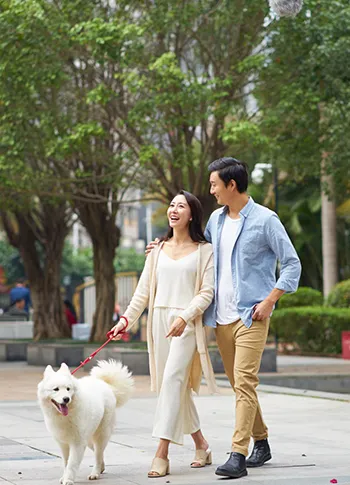
Make walks more engaging by teaching your dog to circle around you:
- Start with a Treat: Hold a treat in your hand to capture your dog’s attention.
- Guide Them Around: Lead your dog around you in a circle with the treat.
- Introduce the Command: While they’re moving around you, say “Around”.
- Reward Completion: Once they complete the circle, give them the treat and praise.
- Practice for Smoothness: Keep practicing for smoother execution and eventual weaning off treats.
30. Look Around
Teach your dog to look left and right on command, enhancing their alertness:
- Grab Their Favorite Treat: Use a treat to catch your dog’s attention.
- Guide Their Gaze: Move the treat from one side of their face to the other, encouraging them to follow with their eyes and head.
- Cue the Behavior: Introduce commands like “Look left” and “Look right” as they turn their head.
- Reward Each Look: Reward them for each successful look in the direction you command.
- Increase the Challenge: Gradually increase the distance you move the treat to encourage more pronounced looking.
31. Jump on Pedestal
Introduce your dog to agility training with this simple pedestal jump:
- Choose a Low Pedestal: Start with a low, stable platform.
- Lure with a Treat: Use a treat to entice your dog onto the pedestal.
- Use a Command: As they jump on, say “Pedestal” or “Jump up”.
- Reward and Praise: Once they’re on the pedestal, reward them with the treat and affection.
- Repeat for Confidence: Practice until your dog confidently jumps onto the pedestal on command.
32. Around the Tree
Add fun to your walks by teaching your dog to circle trees:
- Find a Tree: Start with a tree or pole on your walk.
- Lead with a Treat: Use a treat to guide your dog around the tree.
- Introduce a Command: Say “Tree” or “Around” as they move.
- Celebrate the Circle: Reward them once they complete the circle around the tree.
- Build Up to More Trees: Practice with different trees to generalize the command.
With these tricks, your dog won’t just have fun and get exercise; they’ll also learn useful behaviors that can make your daily routines more enjoyable and interactive.
Frequently Asked Questions
Q: How long should training sessions be?
A: Keep them short and sweet, about 5 to 15 minutes, to maintain your dog’s attention and enthusiasm.
Q: What if my dog loses interest during training?
A: Try using higher-value treats or toys as rewards, and ensure the training environment is free from distractions. Sometimes a short break can also help.
Q: How can I keep my dog motivated?
A: Mix up the rewards (treats, praise, playtime) and the tricks to keep things interesting. Consistent positive reinforcement is key.
Q: My dog performs well at home but not outside. Why?
A: Different environments offer new distractions. Gradually introduce your dog to new places for training, starting in quieter, less distracting areas.
Q: Can old dogs learn new tricks?
A: Absolutely! Older dogs might take a bit longer to learn, but with patience and consistent practice, they can learn just like younger dogs.
Conclusion
Dog training is a journey filled with ups and downs. Remember, every dog is unique, and what works for one might not work for another. The key is to stay patient, positive, and persistent. Celebrate the small victories, and don’t get discouraged by setbacks. With time, understanding, and a lot of love, you and your dog can achieve a wonderful harmony and enjoy the rewarding process of learning together. Keep the sessions fun, and never underestimate the power of treats and praise. Happy training!
